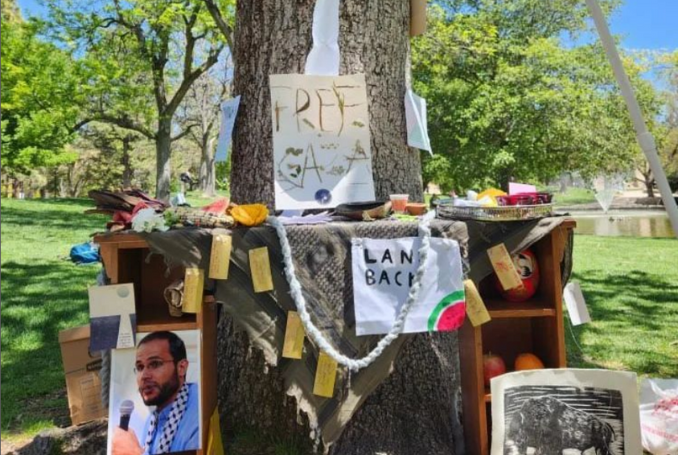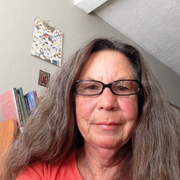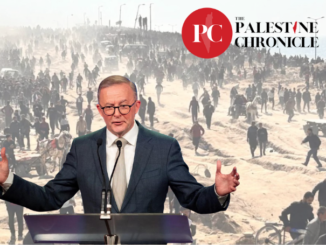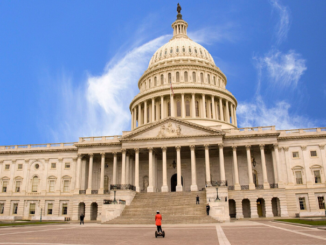
By Benay Blend
In a move that highlights Kanafani’s call for breaking boundaries, students from various associations in Gaza issued a statement calling for a global student bloc.
Shortly after October 7, students at Columbia wrote a statement expressing sympathy for Israeli and Palestinian individuals who had lost family members on that day. What at first sounds like “both sides-ism” evolves into an analysis that holds Israel’s colonial system accountable for its actions.
“The weight of responsibility for the war and casualties undeniably lies with the Israeli extremist government and other Western governments,” the statement reads, “including the U.S. government, which fund and staunchly support Israeli aggression, apartheid and settler-colonization.” It then goes on to bring the issue home by calling for the following: an end to the university’s discrimination against Palestinian students; divestment from joint programs with Israeli institutions, and finally, acknowledgement that under international law, Palestinians have a legal right to resist.
In retaliation, Columbia suspended the charters for Students for Justice in Palestine (SJP) and Jewish Voice for Peace JVP). When the students established an encampment in solidarity with Gaza on the university’s lawn, President Shafik authorized the police to sweep the camps and proceed with mass arrests.
Undaunted, students continue to hold down the protest which has now spread to other campuses. The number of encampments as of a few days ago was at least 50. Aside from the most obvious, that for the first time since perhaps the Occupy movement, there are the origins of a new national, coordinated campaign, there are several other takeaways from the student camps.
In New York City, responses from government and university officials prove that the notion of diversity does not often lead to change. For example, the president of Columbia University, Menouche Shafik, is an Egyptian woman, testified before recent House Education and Workforce hearings that in her mind such chants as “from the river to the sea, Palestine will be free” and “long live the Intifada” are anti-Semitic.
Matching her rhetoric with direct action, Shafik requested that the police perform a sweep of the pro-Palestinian Columbia encampment and arrest students as well as faculty supporting them. By equating Judaism and Zionism, support for Palestinian liberation with terrorism, Shafik has turned the campus into a police state, thereby turning the clock back to pre-1968, before a similar student rebellion led to protections for speech and protest on campus.
State officials have followed suit. New York Governor Kathy Hochul eventually apologized for saying that “there would be no Canada” if it attacked Buffalo, in an analogy to October 7th. By assuming that this is a logical comparison, Hochul glosses over the ways that Israel has turned Gaza into an open air concentration camp, a position that gives it the legal right to resistance.
Hochul went on to explain her desire to visit Israel, a country she believed had endured its own 911, thus comparing the Resistance to the terrorists who struck the towers, again a false analogy that cancelled out her earlier apology. Hochul declined AIPAC’s offer to pay for her trip to Israel but said later that New York taxpayers would foot the bill for the trip.
New York Mayor Eric Adams, a moderate Democrat from the black community, also visited Israel. “I am going to try to find a plot of land so it can be my retirement place,” Mr. Adams told the magazine Mishpacha. “I love the people of Israel, the food, the culture, the dance, everything about Israel.” Apparently Adams has no problem with living on stolen land, a stance that perhaps explains his condemnation of the “antisemitism being spewed at and around the Columbia University campus,” again equating Zionism with Judaism, a false comparison apparently popular with US politicians.
At the University of New Mexico (UNM), the encampment’s launch coincided with Nizhoni Days, an annual celebration of Native culture and education hosted by UNM Native students, Native student organizations, and supporting UNM departments. In a state with a large Indigenous population, it makes sense that there should be connections between stolen land at home and colonialism abroad, with Palestine at the center.
David Correia’s An Enemy Such as This: Larry Casuse and the Fight for Native Liberation on Two Continents over Three Centuries (2022) traces the life and death of Larry Casuse, an Indigenous freedom fighter whose struggle against colonialism in New Mexico, where, Correia writes, settler colonialism was born. His struggle, and indeed his family’s generations-long fight, provides lessons for those fighting against settler colonialism today.
On day 4 of the UNM encampment, April 25, participants are asked to wear red to honor Missing and Murdered Indigenous Relatives (MMIR). Included on the shrine pictured in the above photo there is a graphic of a watermelon, a symbol of Palestine, along with a demand for Land Back.
In honor of Diné-Palestinian Solidarity, activists are showing the film “Spaces of Exception” which draws connections between Rez life and Palestinian refugee camps. Showings are at the Navajo Nation Museum on April 26 and at the Fort Defiance Chapter House on April 27.
Students across multiple Atlanta universities are protesting the genocide of Palestinians as well as the Cop City project, an institution that would destroy the Weelaunee Forest. Moreover, it was managed by the Muscogee and Cherokee peoples before it became a slave plantation then morphed into an Atlanta prison farm.
The proposed destruction of a forest in Atlanta, Georgia in order to make way for Cop City serves as a case study for the ways in which settler colonialisms are connected. The origins of the project can be traced to the Israeli Urban Warfare Training Center (UWTC), funded with $45 million from the U.S. These centers are laboratories for strategies deployed against marginalized peoples that range from occupied Palestine to the working-class and undocumented communities in Atlanta.
At many of these encampments internationalism is on full display, a strategy that harks back to the late Palestinian revolutionary/writer Ghassan Kanafani. As Louis Brehony notes, Kanafani played an important role in placing the Palestinian struggle into an internationalist, anti-imperialist perspective.
“Imperialism has laid its body over the world,” Kanafani wrote, “the head in Eastern Asia, the heart in the Middle East, its arteries reaching Africa and Latin America. Wherever you strike it, you damage it, and you serve the world revolution.”
Given that Kanafani believed the Palestinian cause was not for Palestinians only, but instead belonged to all the “exploited and oppressed masses” of his era, he would have welcomed that sector to join the student movement.
In a move that highlights Kanafani’s call for breaking boundaries, students from various associations in Gaza issued a statement calling for a global student bloc. “It is time to smash the US imperialist war machine,” they declared. “From Gaza to Columbia, to Ann Arbor and Berkeley, our hands are joined to end Nazi genocide and achieve our collective liberation.”
Writing for Mondoweiss, Yumna Patel recalls her participation in Students for Justice in Palestine (SJP) at NYU at a time ten years ago when protests did not draw the crowds that it does today. “We are witnessing history in real time,” she writes, “and one can’t help but feel that while the crackdowns will no doubt escalate, these students are charting a new path forward in this country. A path that rejects colonization and imperialism, and rejects the complicity of our academic institutions in the U.S. war machine and in global oppression.”
Despite her elation, Patel expresses fear that “protests that were quite literally started in order to bring attention to the genocide in Gaza, have instead themselves become the story.” Rather than blaming students, who she believes are acting in good faith, she calls on the media to continue centering news from Gaza, where reports of mass graves have just unfolded.
Though Israel has targeted educational institutions in Gaza time and time again, its students are still determined to continue their studies. On April 15, Palestine Chronicle Gaza correspondent Abdallah Aljamal posted an interview with Mohammed Abu al-Rous, a teacher at the Malaysian Quranic School on the outskirts of the Nuseirat camp.
Though Israel tries to destroy the rights of children to their education, they will not win. “We will teach our children in tents, under the sun, and anywhere else,” declared Abu al-Rous. “We are determined to raise an educated and informed Palestinian generation, capable of resisting the occupation and exposing its crimes in all international forums.”
This is the story, Abu al-Rous and others like him. The student camps are there in solidarity to make sure that they succeed.

– Benay Blend earned her doctorate in American Studies from the University of New Mexico. Her scholarly works include Douglas Vakoch and Sam Mickey, Eds. (2017), “’Neither Homeland Nor Exile are Words’: ‘Situated Knowledge’ in the Works of Palestinian and Native American Writers”. She contributed this article to The Palestine Chronicle.







